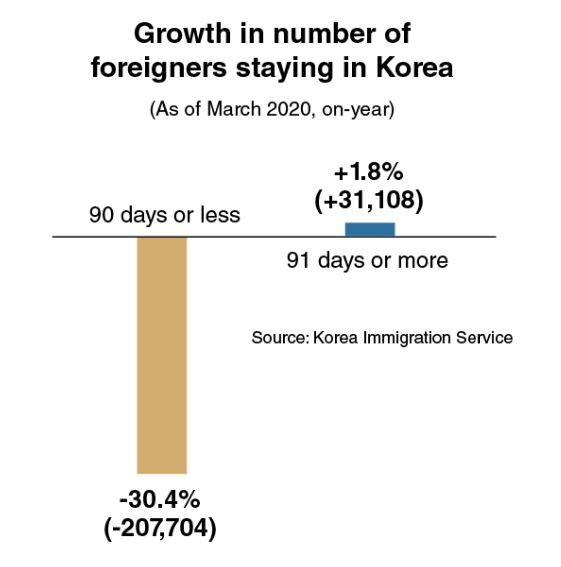[News Focus] Long-term foreign residents up on-year despite virus
Short-term inbound travelers may rebound amid debate on risks
By Kim Yon-sePublished : May 7, 2020 - 14:18

SEJONG -- The number of foreigners staying in South Korea -- both short-term and long-term collectivley -- stood at 2.2 million as of March, according to the Korea Immigration Service.
The figure marked a 7.4 percent decline from 2.37 million a year earlier, in the wake of the novel coronavirus that has affected the nation since late January.
But the data showed a disparity between short-term and long-term inbound visitors, which classifies the two brackets with a cutoff of 90 days.
The number of short-term visitors -- who were supposed to stay for 90 days or less in Korea -- fell by 30.4 percent (minus 207,704) from 682,814 as of March 2019 to 475,110 as of March 2020.
In contrast, the number of long-term (including mid-term as an unofficial classification) visitors -- allowed to stay for 91 days or more -- climbed 1.8 percent (plus 31,108) from 1.696 million to 1.728 million over the corresponding period.
Though the figure for long-term visitors (many of whom are foreign residents) also inched down, when it is compared to three months earlier in December 2019 (1.731 million), the state data, anyway, clarified an “on-year” increase despite the COVID-19 situation.

As the spreading pace of the epidemic has weakened in the nation since early April after peaking in early and mid-March, some observers began cautiously raising the possibility that the figure for foreigners staying for the long-term will outnumber the figure for December 2019 in the coming months.
“After touching the bottom between March and May, the inbound traveler scale could possibly normalize starting from the summer vacation period,” said a tourism industry analyst.
But others say it is premature to comment on normalizing the volume of inbound travelers amid the ongoing pandemic involving travelers’ homelands. They say the urgent issue is not normalization but maintenance of the quarantine process at airports at the highest level at least for several months longer.
After topping the 1 million mark in 2010 for the first time in history, the number of foreigners staying here for 91 days or more (long-term visitors) has continued, surpassing 1.5 million in 2016 and approaching 1.8 million recently.
The trend for short-term visitors was the same -- from 258,000 in December 2010 to approaching 800,000 as of December 2019.
By generation, those in their 30s topped visiting age groups with 27.3 percent (514,485 foreigners among 2.2 million for both short and long-term) as of March, trailed by those in their 20s at 23.4 percent, those in their 40s with 16.2 percent and those in their 50s with 14.5 percent. Those aged 60 or over and those under 20 made up 12.3 percent and 6.3 percent, respectively.
By nationality, Chinese -- including Korean Chinese -- accounted for the greatest group with 978,096, followed by Vietnamese with 219,784, Thais at 191,852, Americans with 145,949, Uzbeks with 73,706 and Russians with 56,377.
While the number inched down by each nationality compared to December 2019, the tally for inbound visitors from Japan, Taiwan, Australia and Malaysia posted a sharp drop amid the coronavirus phase.
Japanese among them marked the steepest fall during the three-month period from 86,196 to 29,140. The figure for Australia went from 15,222 to 8,600, and Malaysia fell from 14,700 to 6,891.
Of the 1.728 million foreigners staying for the long term as of March, 1.264 million were registered as residents in eight major cities and nine provinces, according to the data from the Justice Ministry-based immigration service.
Gyeonggi Province topped the list, where 32.8 percent of them reside, followed by Seoul with 22.1 percent, South Gyeongsang Province with 5.9 percent, Incheon with 5.8 percent and South Chungcheong Province with 5.6 percent.
Meanwhile, the number of immigrants staying here illegally increased for both short- and long-term stays, compared to a year earlier, by 8.7 percent from 365,095 to 387,001, collectively. They are included as part of the total figure of 2.2 million foreigners staying in the nation.
By Kim Yon-se (kys@heraldcorp.com)







![[KH Explains] How should Korea adjust its trade defenses against Chinese EVs?](http://res.heraldm.com/phpwas/restmb_idxmake.php?idx=644&simg=/content/image/2024/04/15/20240415050562_0.jpg&u=20240415144419)










![[Today’s K-pop] Stray Kids to return soon: report](http://res.heraldm.com/phpwas/restmb_idxmake.php?idx=642&simg=/content/image/2024/04/16/20240416050713_0.jpg&u=)